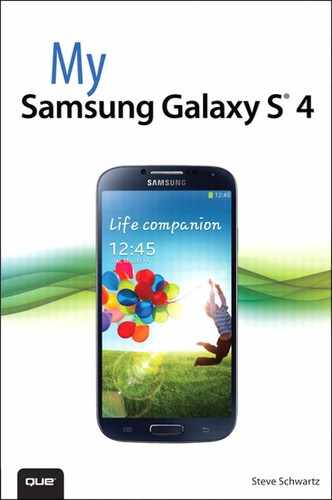6. Using the Calendar

In this chapter, you find out how to use Calendar to create, view, and edit events and tasks. Topics include the following:
→ Creating events and tasks, viewing the calendar, and managing events and tasks
→ Responding to reminders for upcoming events and tasks
→ Setting Calendar preferences
Similar in design to a full-featured calendar application (such as the one in Microsoft Outlook), the Calendar app enables you to record upcoming events, meetings, and tasks and then receive reminders for them. If you already maintain calendars in Google, Facebook, Hotmail (Microsoft Exchange ActiveSync), or a corporate Exchange Server account, you can synchronize your Calendar app data with that of your other calendars.
Adding Calendar Accounts
If you’ve used a Google/Gmail account on your phone to access any Google service, Calendar has two calendars that it can immediately associate with new events and tasks: your Google/Gmail Calendar and My Calendar, a phone-specific calendar created by the Calendar app. In addition to these sources, Calendar can use data from and sync with Samsung, Facebook, and Microsoft Exchange Server calendars. Thus, before you experiment extensively with Calendar, decide which external calendar sources you want to use and keep in sync with Calendar (adding other accounts as needed). You can find instructions for automatically and manually synchronizing your calendar data in Chapter 16.
1. To add a Facebook, Microsoft Exchange Server, Samsung, or Gmail calendar account (only these account types support calendar syncing with your phone), go to the Home screen and tap Apps, followed by Settings.
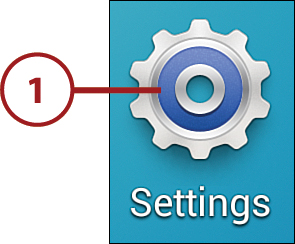
2. On the Settings screen, select the Accounts tab.
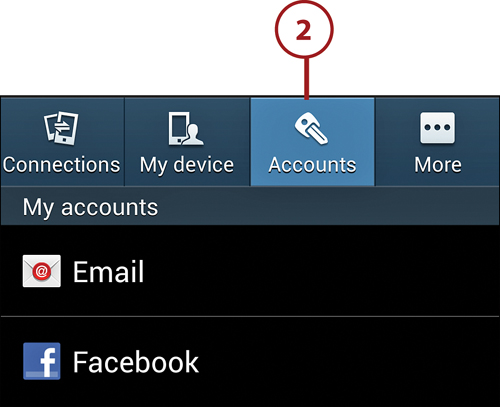
3. At the bottom of the My Accounts list, tap Add Account.
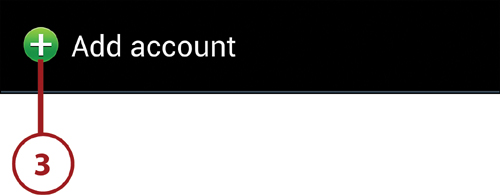
Multiple Accounts of the Same Type
Account types that are marked with a green dot have already been added. You can have multiple Exchange and Google accounts, but only one instance each of Samsung and Facebook accounts.
4. Select one of these account types: Sync Apps with Facebook, Microsoft Exchange ActiveSync, Google, or Samsung Account.
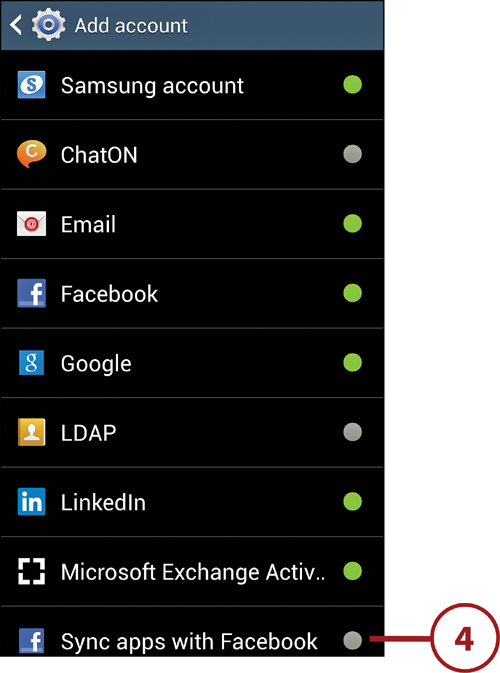
5. Follow the instructions to add the account. At a minimum, you need to supply your username and password (or use the provided option to create an account).
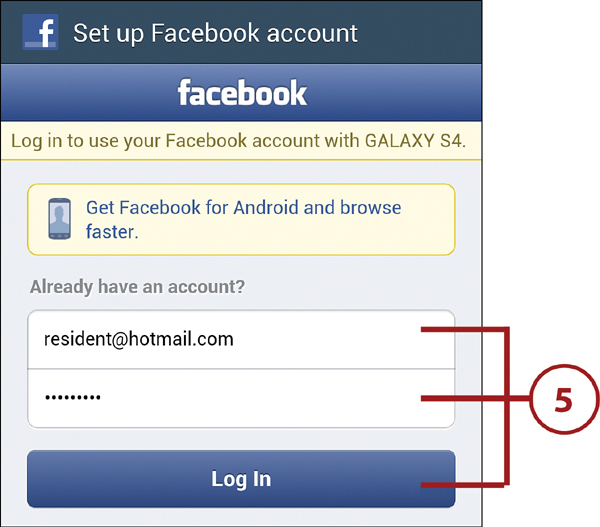
6. If offered as an option, ensure that Sync Calendar is enabled.
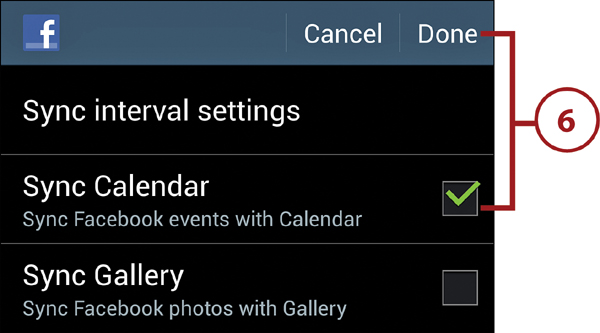
7. You can add other accounts by repeating steps 3–6. When you finish, press the Home key to return to the Home screen.
Working in Calendar
Within Calendar, you can create events and tasks, set a view (Year, Month, Week, Day, List, or Task), and edit or delete events and tasks.
Creating Events and Tasks
In addition to events and tasks that are pulled from your Gmail/Google, Facebook, Exchange, and Samsung accounts, you can also create new items within the Calendar app. These new items can be synced with your accounts automatically, manually, or not at all (as explained in Chapter 16).
Every Calendar item is either an event (a scheduled item for a specific date, with or without a start time) or a task (an unscheduled item with or without a due date). An event can be an all-day occurrence, such as a vacation day or birthday, or have a defined start and end time.
Creating an Event
1. Launch the Calendar app by tapping its Home screen shortcut or by tapping Apps, followed by Calendar.

2. Optional: On the calendar, select the date or time when you want to schedule the event. (Selecting the start date or time saves you the trouble of specifying this information when you create the event.) To change the Calendar view so that you can pick a start date or time, tap the Month, Week, or Day tab.
3. Tap the plus (+) icon to create a new event.
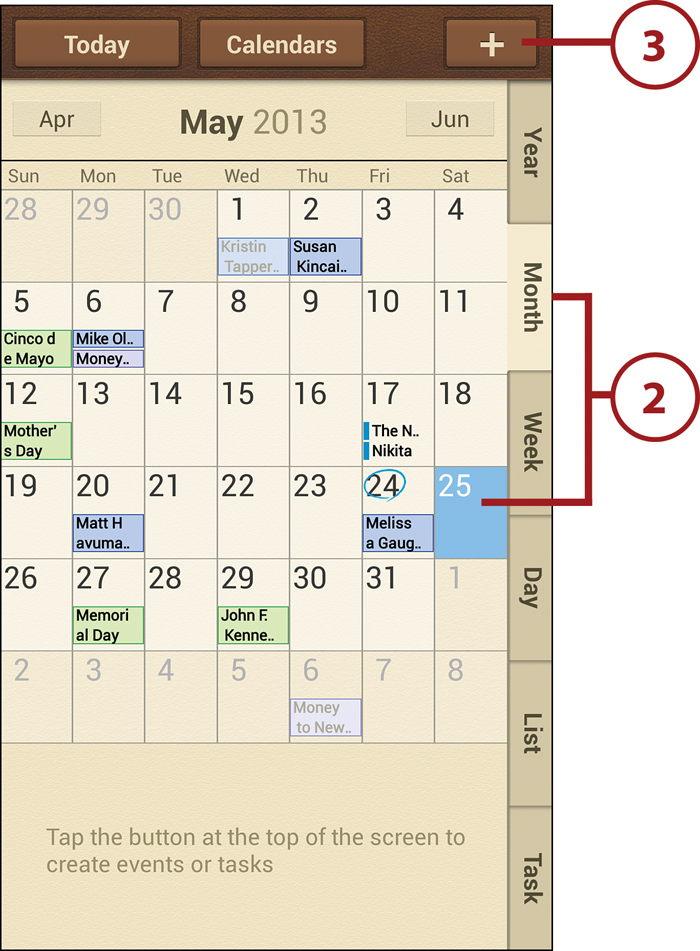
Be General or Specific
The more specific your selection (start date or date/time), the more information is prefilled for the event. On the other hand, regardless of the currently selected date or start time, you can still set a different date or time when you create the event.
Another Plus Icon Option
You can also create a new event or task by tapping the plus icon in a Calendar widget.
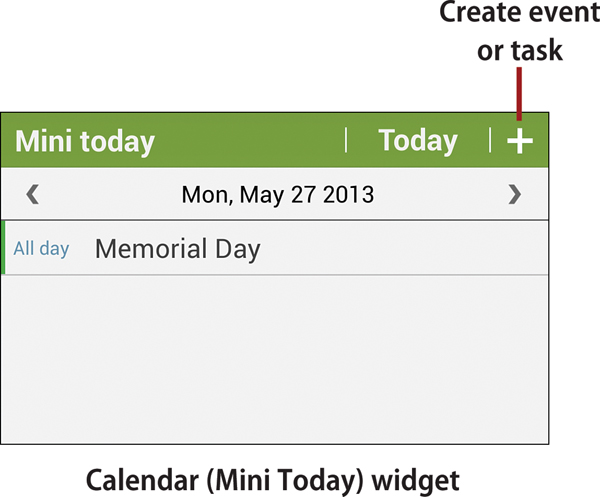
4. The scheduling screen appears. Ensure that the Add Event tab is selected. (When selected, the tab is dark.)
5. To associate the event with a different calendar, tap Calendar and select an account to use. (My Calendar is the phone-specific calendar.)

Using Multiple Calendars
The calendar you specify for each new item is very important. When you sync calendars, it’s the calendar that records the event. If you choose your Google/Gmail calendar, for example, the event will also be available to you from Google’s website using any browser. On the other hand, if you choose My Calendar, the event will be available only on your Galaxy S 4. To use other account calendars with Calendar, see “Adding Calendar Accounts” at the beginning of this chapter.
6. Enter a title for the event.
7. Optional: Select a sticker (icon) or color that signifies something about or helps classify the event.
8. Do one of the following:
• If this is an all-day event or one with no specific schedule other than the day on which it occurs, tap the All Day check box. The From and To times are removed, as well as the time zone. Go to step 9.
• If the From (starting) date or time is incorrect, tap the date or time item and correct it. Tap arrow icons to increment or decrement a component (such as the hour) by one unit. Alternatively, you can select the item you want to change and type the new value. Tap Set to accept the corrected date or time. Repeat this process for the To (ending) date and time.
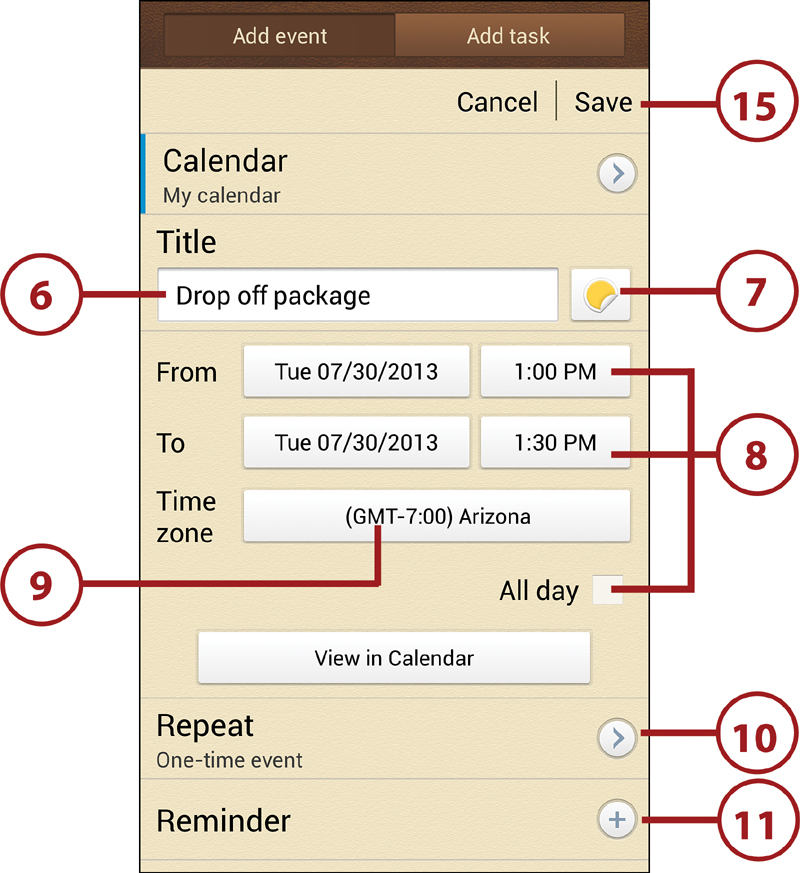

9. Optional: Tap the Time Zone entry to specify a different time zone to use for scheduling this event.
10. If the event will repeat at regular intervals (such as a weekly staff meeting on Monday at 1:00 p.m.), tap Repeat and select a repetition interval. Then specify a duration or end date, and tap OK.
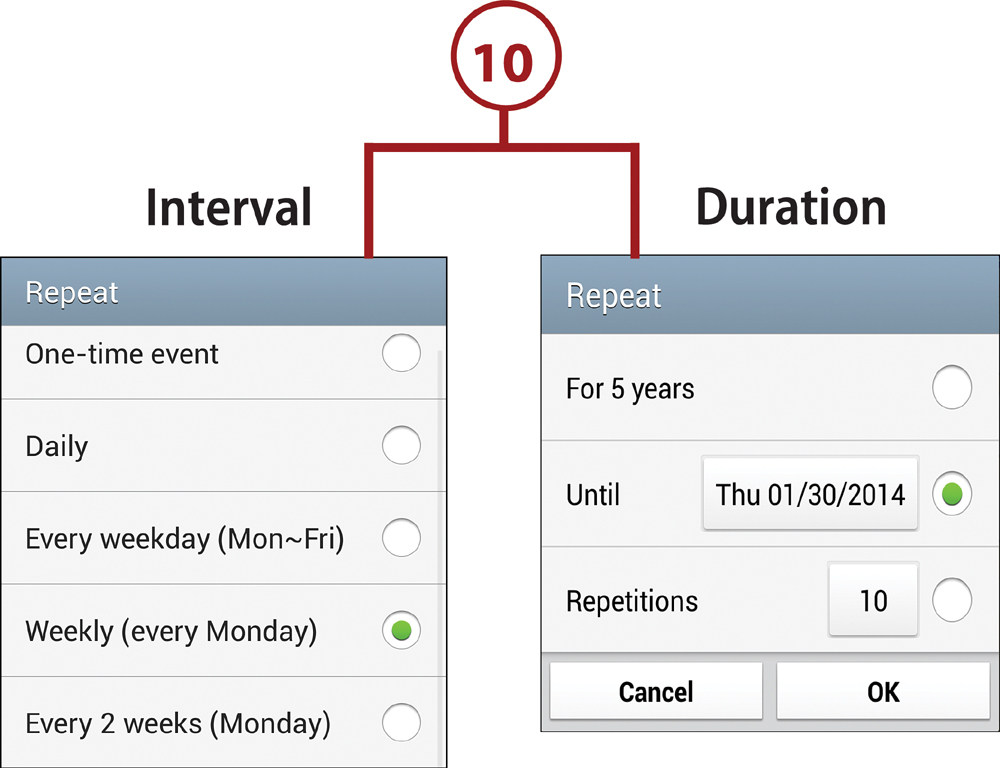
11. Optional: You can set a reminder (alarm) for the event by tapping the Reminder plus (+) icon. To specify an interval other than the default (15 mins before), tap the interval box, and select a new one from the scrolling list. (Select Customize if none of the intervals is correct.)
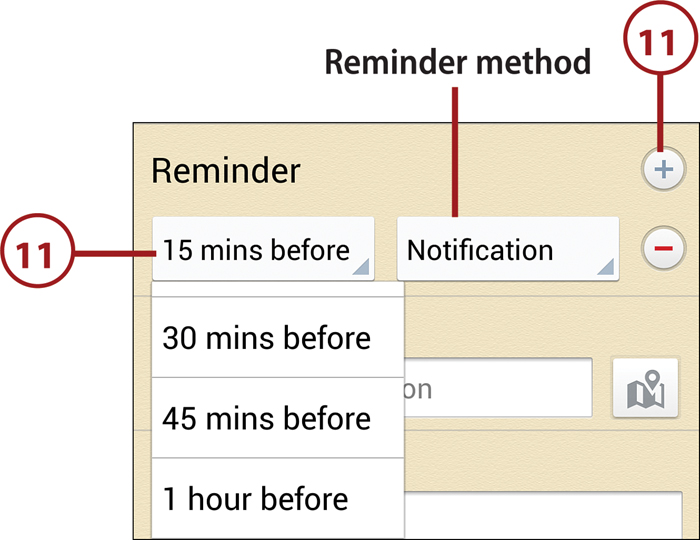
More About Reminders
You can optionally set multiple reminders for an event. Tap the plus (+) icon to add a new reminder. To remove a reminder, tap the minus (–) icon to its right. If the Calendar account with which this event is associated has an email address (such as your Google/Gmail account), you can elect to be notified via email rather than by the usual methods. Tap the box to the right of the reminder interval and choose Email.
12. Optional: Enter a location for the event by typing in the Location box, or by tapping the Location icon, performing a search, and tapping Done.
13. Optional: In the Description text box, enter a detailed description of or notes related to the event.
14. You can attach existing or new S Memos or photos to the event by tapping the Memos or Images plus (+) icon.
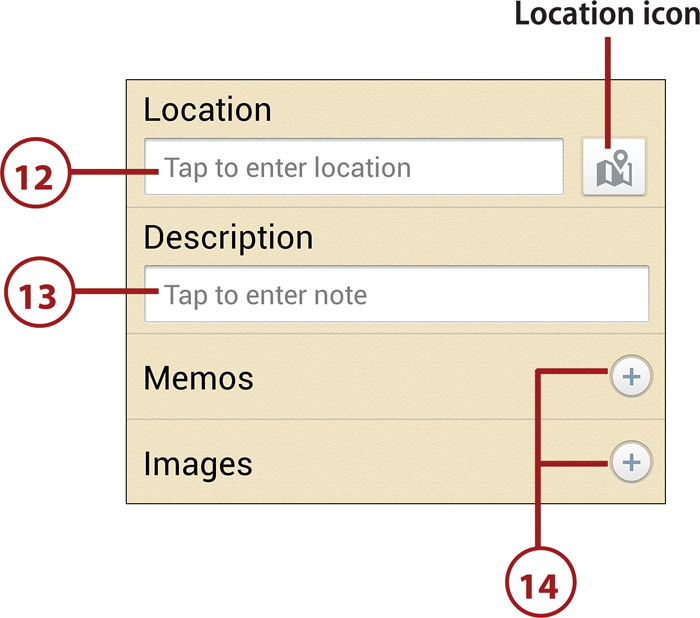
Advanced Calendaring
To maintain compatibility with events created in Google/Gmail and Microsoft Exchange ActiveSync accounts (or created in Calendar and designated as either of these account types), additional fields (Participants, Show Me As, and Privacy) appear when you create, edit, or view such events. The fields are normally used to manage attendance at corporate meetings and can—or should—be skipped when creating standard Calendar events. When you save an item with designated participants, each person is automatically emailed an invitation when you save the event.
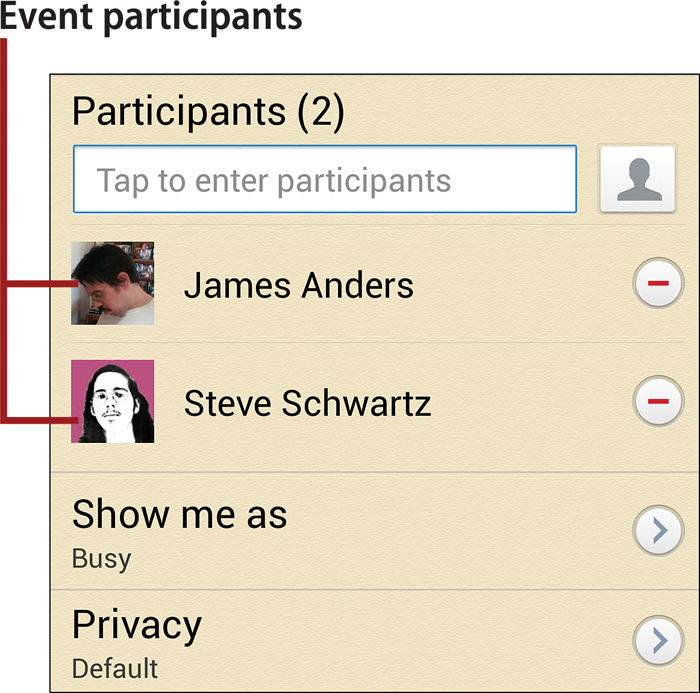
15. Tap the Save button to add the event to the calendar or tap Cancel to discard it.
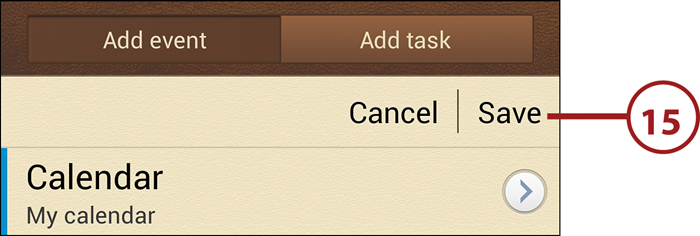
The Minimalist Approach
Unless you’re a stickler for detail, it’s quickest to enter only the essential information for each new event or task: the Title and the scheduled date/time. In addition to following the steps in this task, you can use the following shortcut.
In Month, Week, or Day view, tap to select a date, date/time, or time slot, respectively. Tap the selected period again to open a basic Add Event dialog box. Select the Add Event or Add Task tab (displayed in Month view only), enter an event or task title, and tap Save. If you need to enter more details, tap Edit Event Details, enter the necessary information, and then tap Save.
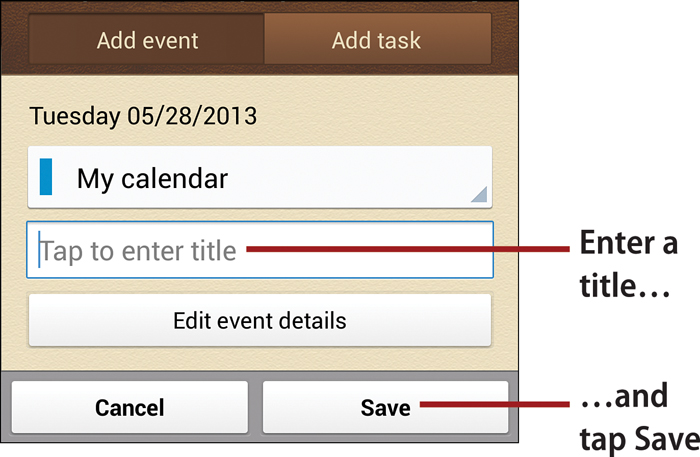
Creating a Task
1. Launch the Calendar app by tapping its Home screen shortcut or by tapping Apps, followed by Calendar.
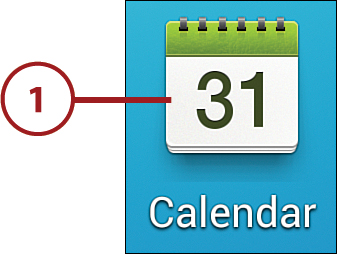
2. Optional: On the calendar, select the due date for the task’s completion. (Selecting the date saves you the trouble of specifying it when you create the task.) To change the Calendar view so that you can select a due date, tap the Month, Week, or Day tab.
3. Tap the plus (+) icon.
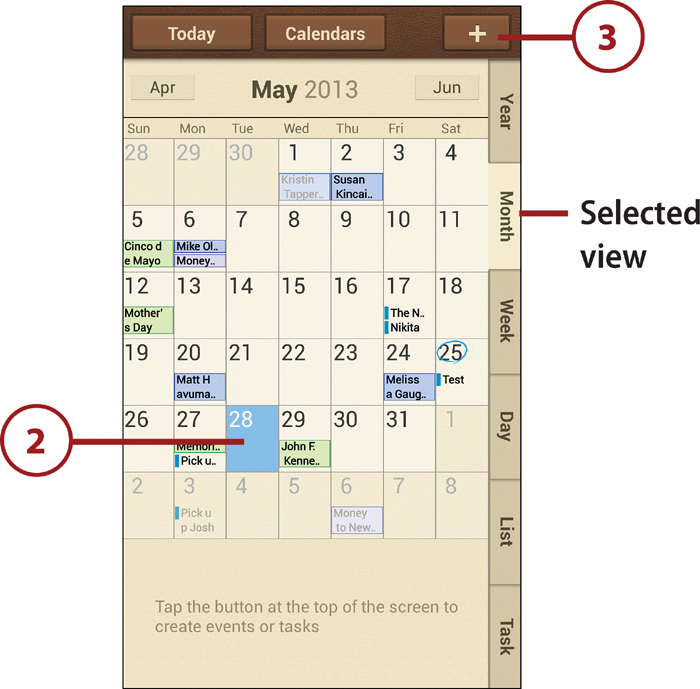
4. The scheduling screen appears. Ensure that the Add Task tab is selected. (When selected, the tab is dark.)
5. To associate the task with a different account, tap Task and select the account to use. (My Task is the phone-specific account.)
6. Enter a title for the task.
7. Do one of the following:
• If there’s a particular date on or by which the task must be completed, tap the Due Date button, specify the date in the Set Date dialog box, and tap the Set button.
• If the task is open-ended, tap the No Due Date check box.
8. Optional: You can set a reminder (alarm) for the task by tapping the arrow icon. In the Reminder dialog box, select either On Due Date or Customize (to specify a different date). The selected date and the current time are set as the reminder. To change the time, tap its entry, specify the time in the Set Time dialog box, and tap the Set button.

9. Optional: Specify a completion priority (high, medium, or low) by tapping the arrow icon.
10. Optional: In the Description text box, enter a detailed description of or notes related to the task.
11. You can attach existing or new S Memos or photos to the task by tapping the Memos or Images plus (+) icon.
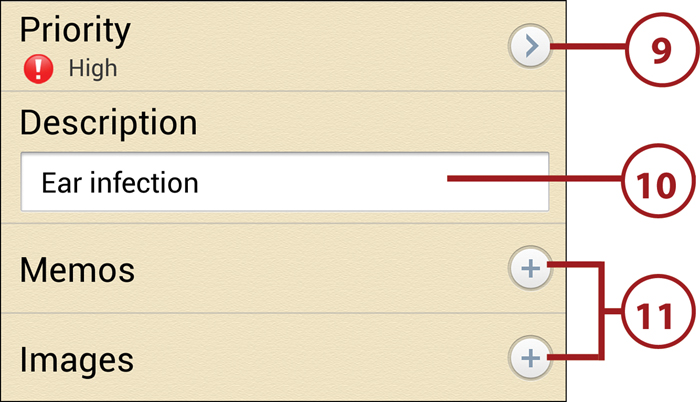
12. Tap the Save button to add the task to the calendar or tap Cancel to discard it. (When added to a calendar, a task is preceded by a check box.)

Viewing the Calendar
Calendar has six views: Year, Month, Week, Day, List, and Task. You interact differently with Calendar in each view.
1. When you launch Calendar, the last displayed view appears. To change views, tap a different view tab. The tab for the current view is beige.

2. Year view. You can’t view events or tasks in Year view. Its purpose is to enable you to easily select a month for viewing—in this or another year. Scroll to previous or future years by tapping the arrow icons or by swiping the screen horizontally. When the target month and year appear, tap the month to view it in Month view.
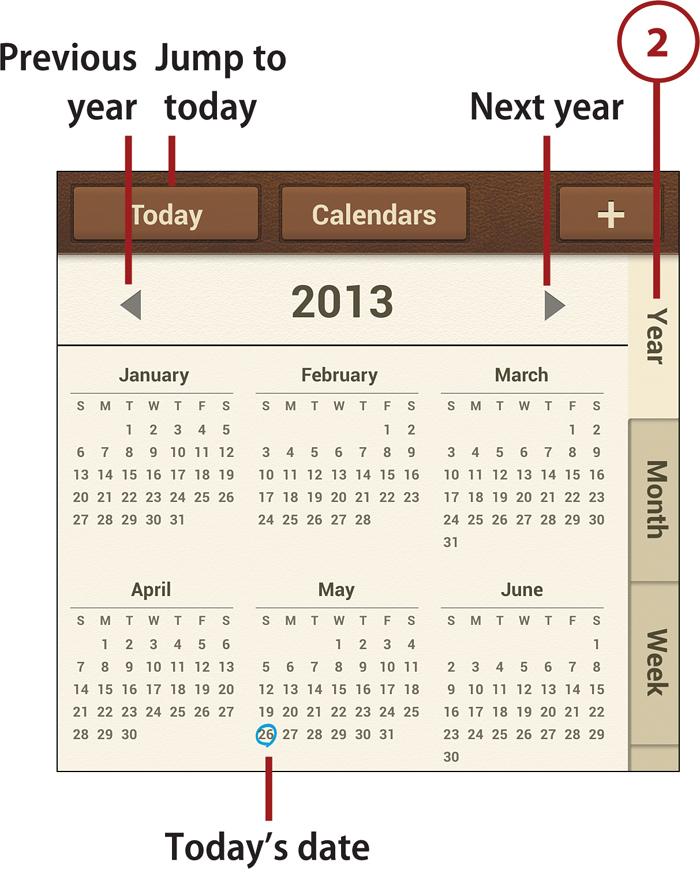
Other Year View Options
To immediately return to the current year, tap the Today button. Today’s date is encircled in blue.
3. Month view. In Month view, the event/task text is color-coded to match the calendar account with which the item is associated. For example, bright blue text is used to show My Calendar items, dark blue for Facebook events, and purple for Google Calendar items. Select a date to display events and tasks for that date at the bottom of the screen or in a pop-up window (depending on a Calendar Settings option). To move forward or back one month, tap a month name or flick the screen vertically or horizontally.
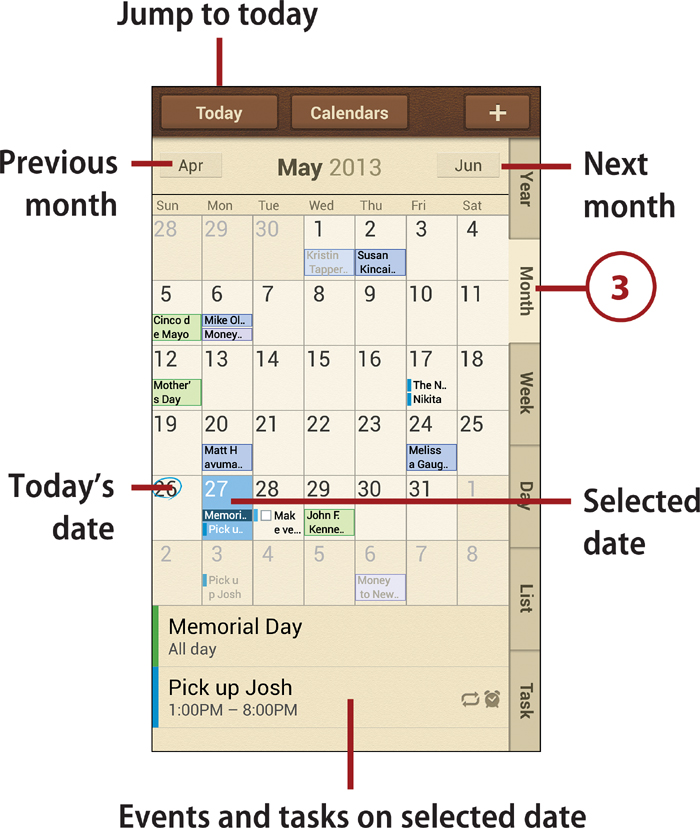
4. Week view. In Week view, items are colored-coded to match the calendar with which they’re associated. Tap an item to view its details, edit, or delete it. Scroll to the previous or next week by tapping an arrow icon or flicking horizontally.
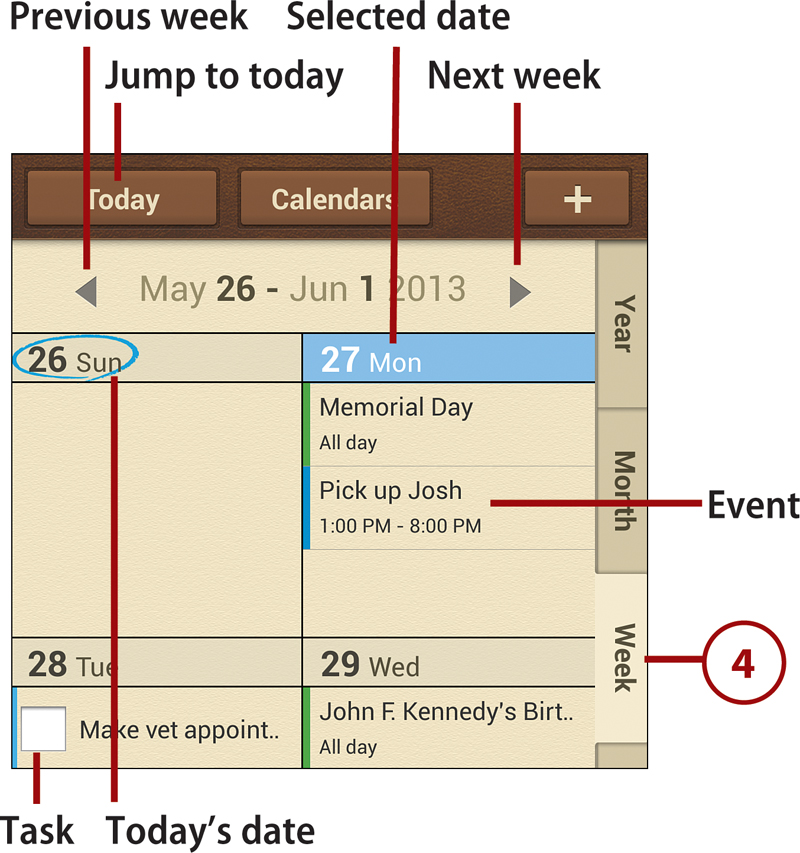
Alternative Styles for Week and Month Views
There are two different styles for displaying events and tasks in Week view and Month view. To switch view styles, press the Menu key, and tap Settings, View Styles, Week View (or Month View Styles). See “Setting Calendar Preferences” at the end of the chapter for more information.
5. Day view. Use Day view to see scheduled items and their duration for a selected date. Items are colored-coded to match the calendar with which they’re associated. Tap an item to view its details, edit, or delete it. Press and hold a time slot to create a new item with that start time. You can scroll the day’s time slots by flicking vertically and switch days by tapping arrow icons or swiping horizontally.

6. List and Task views. Select these views to see a chronological list of events or tasks, respectively. Items are color-coded to match the calendar with which they’re associated. Tap an item to view its details, edit, or delete it. Scroll through the list by flicking vertically. In List view, you can display additional older or future events by tapping Tap to Look for More at the top or bottom of the list, respectively. You can search for events or tasks by entering search text in the box and choosing a filter (All, Event, Task, or Sticker).
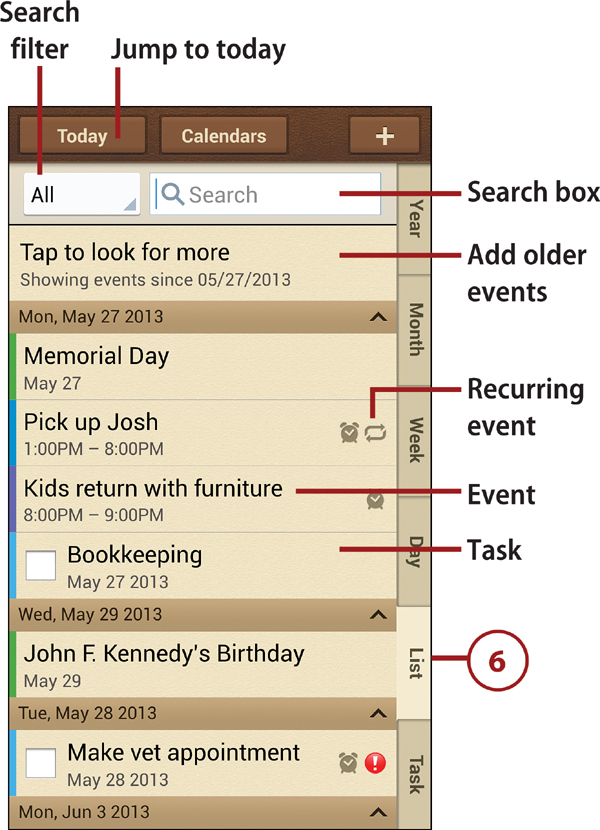
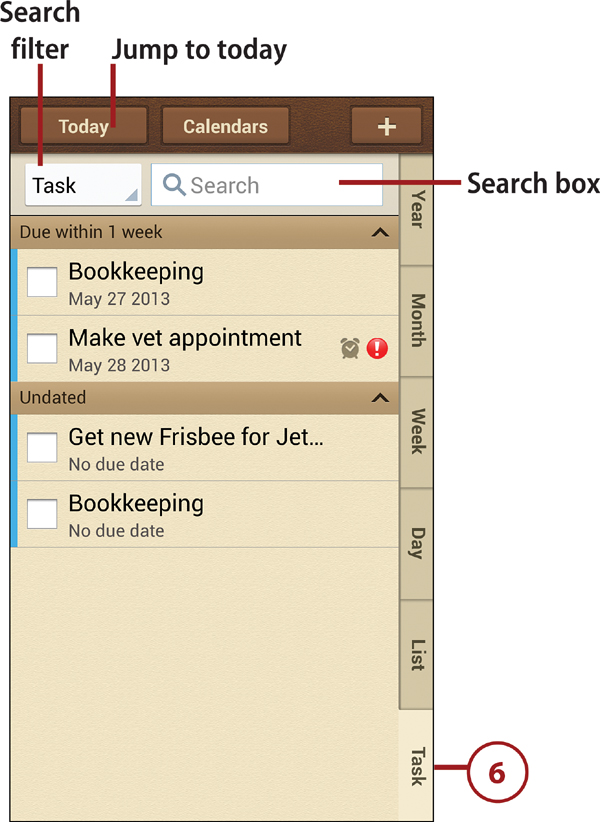
Searching in Other Views
To display the search box in other views, press the Menu key and tap Search.
Sorting Tasks
You can change the sort order in Task view by pressing the Menu key, tapping Sort By, and making a selection.
7. To go to a specific date (in any view except Task), press the Menu key and tap Go To. In the Go To dialog box, specify the target date and tap Done.
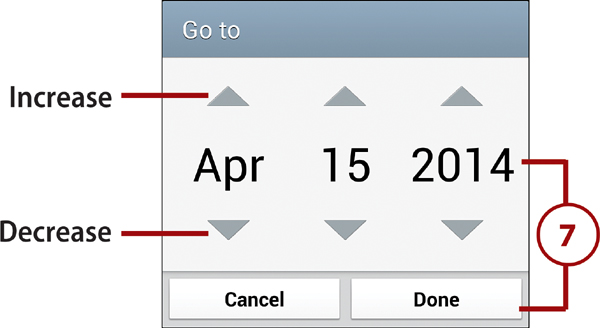
8. You can display events and tasks from one or multiple calendar accounts. To select accounts to show, tap the Calendars button at the top of the current view, select the calendar and task accounts to display, and tap Done.
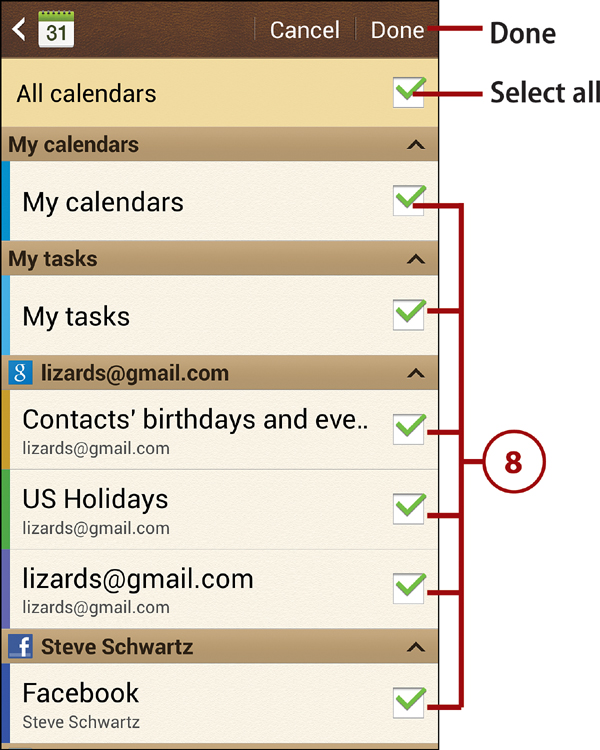
Managing Events and Tasks
After creating an event or task, you can delete or edit any aspect of it, such as the title, start date, start time, description, reminder interval, or completion status.
1. Open the Calendar app and, in any view, tap the item that you want to delete or edit. The item opens in detail view.
Faster Editing, Deleting, and Rescheduling
If you press and hold an item on the calendar, a menu appears that enables you to go directly into edit mode or delete the item without first switching to detail view. In Week and Day views, you can change the date/time or duration of an event by dragging in the Calendar. To reschedule the event, press and drag it to a new date/time slot. To change its duration, drag the event’s bottom edge down or up. When examining an event in detail view, you can tap the item title to immediately switch to edit mode.
2. Press the Menu key and do one of the following:
• To delete the item, tap Delete and then tap OK in the confirmation dialog box. (If multiple items are displayed for a date, you can delete all or only selected ones by tapping their check boxes.)
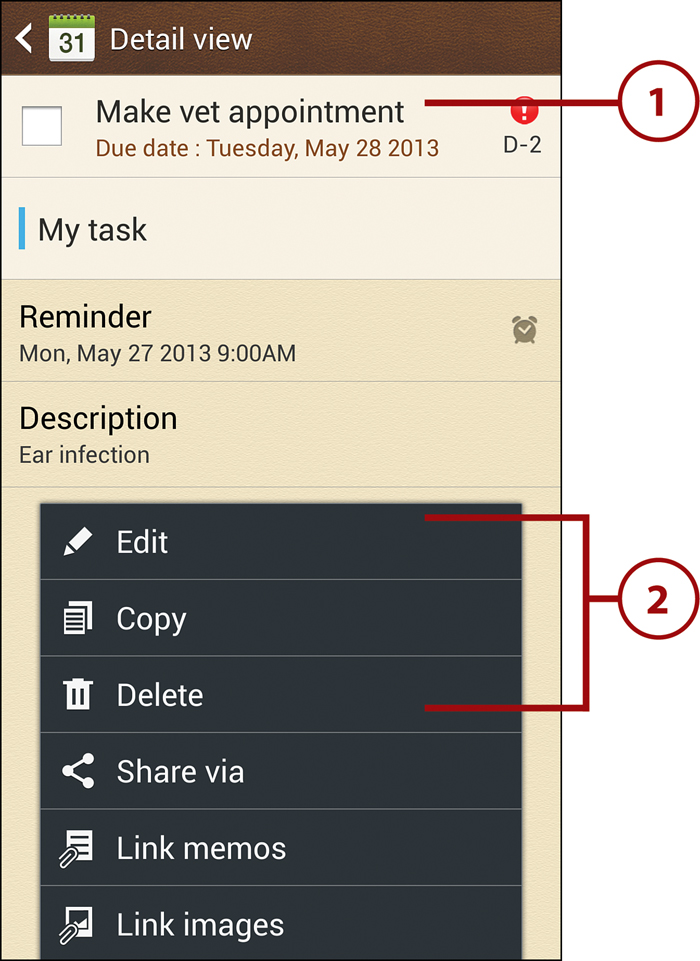
• To modify the item, tap Edit. Make the changes and tap the Save button.
Task Completion
To mark a task complete, tap its check box.
Editing a Repeating Event
When you edit a repeating event, a dialog box appears that enables you to change only this occurrence, all occurrences forward, or every occurrence. A dialog box with similar options appears when deleting a repeating event.
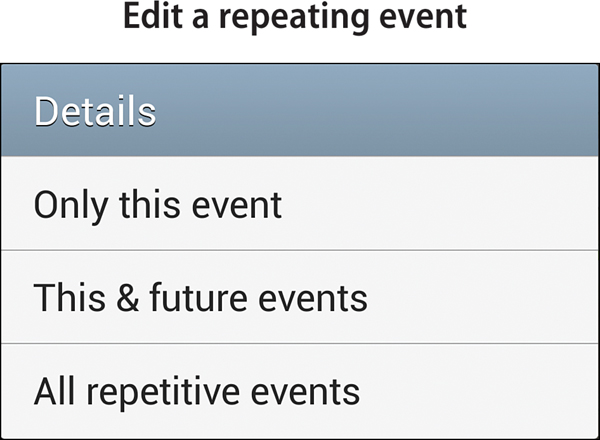
Responding to Reminders
When an event or task reminder is triggered, a message appears briefly in the status bar and is replaced by a number (denoting the number of current alerts) or a separate alert screen appears. A distinctive ringtone may also play. The notification methods used are determined by Event Notification settings, as explained in “Setting Calendar Preferences,” later in this chapter. You can respond to a reminder by snoozing (requesting that it repeat later), dismissing, or ignoring it.
Simple Alarms
If you just need an alarm to remind you that it’s time to wake up or do something, you don’t need to schedule a Calendar event. You can create alarms in the Clock app.
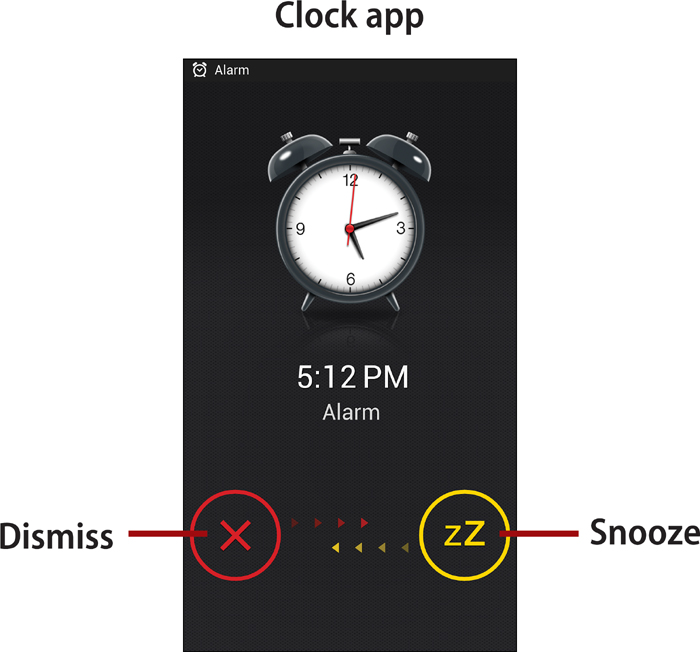
1. If the Set Alerts and Notifications setting is Status Bar Notification, an icon showing the number of waiting reminders appears in the status bar. Pull down the Notification panel and tap the reminder that you want to handle.
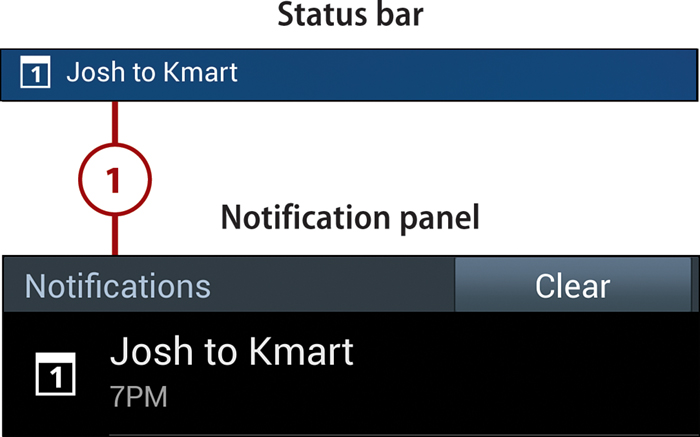
2. If the Set Alerts and Notifications setting is Alert (or you tapped the reminder in the Notification panel in step 1), an icon showing the number of reminders appears in the status bar and the Event Notifications screen appears. One or multiple waiting reminders may be presented at a time.
3. Specify the reminders to which you want to respond by doing one of the following:
• If there’s only one waiting reminder, skip to step 4.
• To respond the same way to all listed reminders, ensure that they’re all checked. (Tap Select All to simultaneously check or uncheck all reminders.)
• To respond the same way to multiple—but not all—reminders, ensure that only the reminders to which you want to respond are checked.
4. Do one of the following:
• To repeat the selected reminder(s) after the current snooze duration (such as 5 minutes) has passed, tap the Snooze button.
• To snooze the selected reminder(s) for a custom duration, tap the Set Snooze Duration button, select the duration and tap OK, and then tap the Snooze button.
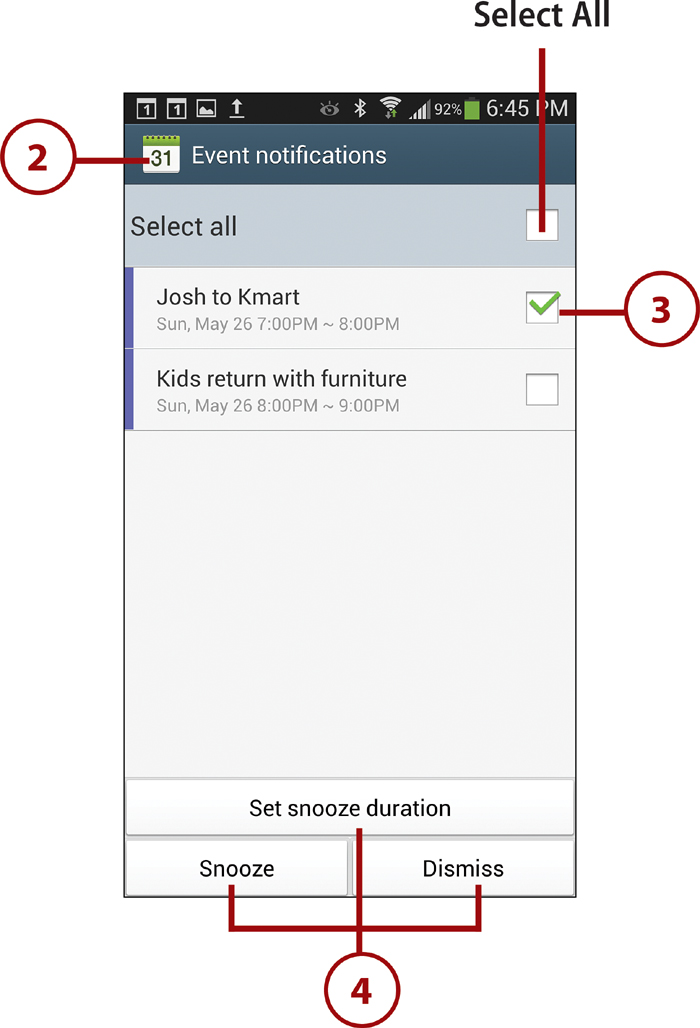
• To cancel the selected reminder(s), tap Dismiss.
• To ignore the reminders for now, press the Back key. You can return to them when it’s convenient by opening the Notification panel, as explained in step 1.
Dismissing a Reminder
Dismissing an event or task’s reminder doesn’t delete the item from Calendar; it merely eliminates the reminder. To delete the event or task, you must perform the procedure described in “Managing Events and Tasks,” earlier in this chapter.
5. Optional: To respond to other waiting reminders, repeat steps 3 and 4.
Responding to a Lock Screen Reminder
A full-screen notification appears when the screen is dark; that is, when the lock screen is active. To respond, press and drag the Dismiss (X) or Snooze (zZ) icon. If you elect to snooze, the reminder is snoozed for the default duration.
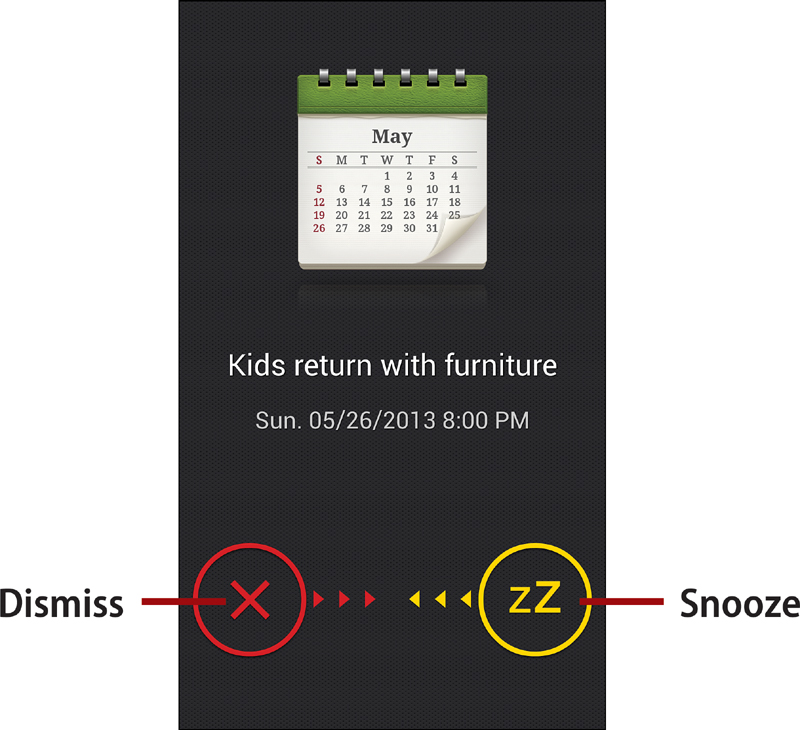
Setting Calendar Preferences
You can set options on Calendar’s Settings screen to customize the way the app works.
1. Launch the Calendar app. (On the Home screen, tap the Calendar shortcut, or tap the Apps icon and then the Calendar icon.)

2. Press the Menu key and tap Settings to view the Settings screen.
3. View Styles. Choose a display option for Month view (Calendar View + List or Calendar View + Pop-up) and Week view (Analog or Timeline).
4. First Day of Week. Specify whether calendar weeks should start on Saturday, Sunday, Monday, or match local customs.
5. Hide Declined Events. When enabled, event invitations that you’ve declined aren’t shown in Calendar.
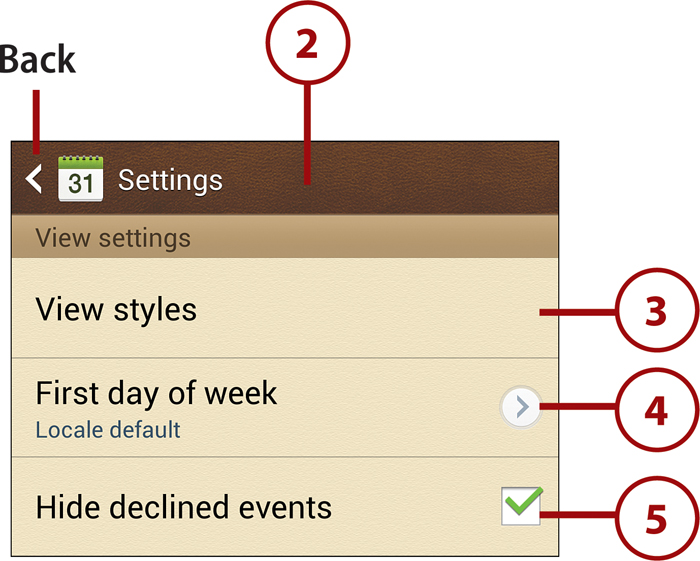
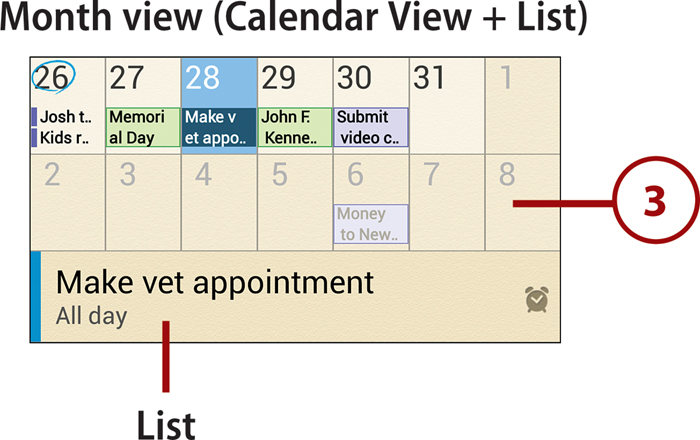
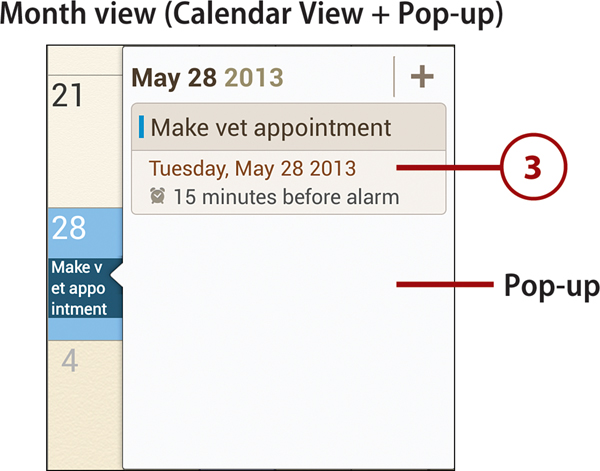
6. Lock Time Zone. When Lock Time Zone is disabled (unchecked), all event times reflect the phone’s current location. When enabled (checked), event times always reflect the time zone specified in Select Time Zone (see step 7).
A Lock Time Zone Recommendation
This is one of the most confusing aspects of Calendar. In general, the easiest way to use Lock Time Zone is to leave it disabled. When you’re home in California, for example, all event times reflect Pacific time. If you travel to New York, the events display Eastern times. Finally, when you return home, events automatically change to show Pacific times again.
7. Select Time Zone. To force all event times to reflect a particular time zone (when you’re traveling or if you want events to always reflect the home office’s time zone, for example), enable Lock Time Zone (see step 6) and tap Select Time Zone to choose a time zone.
8. Show Week Number. When enabled, Week view also displays the week number (1–52).
9. Calendars. Tap Calendars followed by the Display button to specify the account calendars from which events and task are shown, as well as whether birthdays in Contacts records are listed as events. Tap Done when you finish making changes.
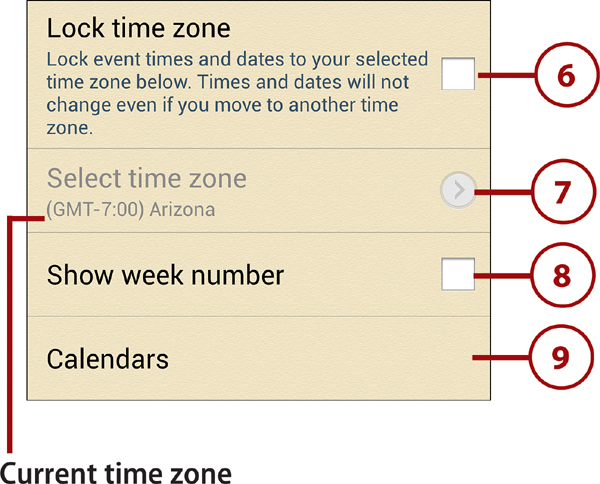

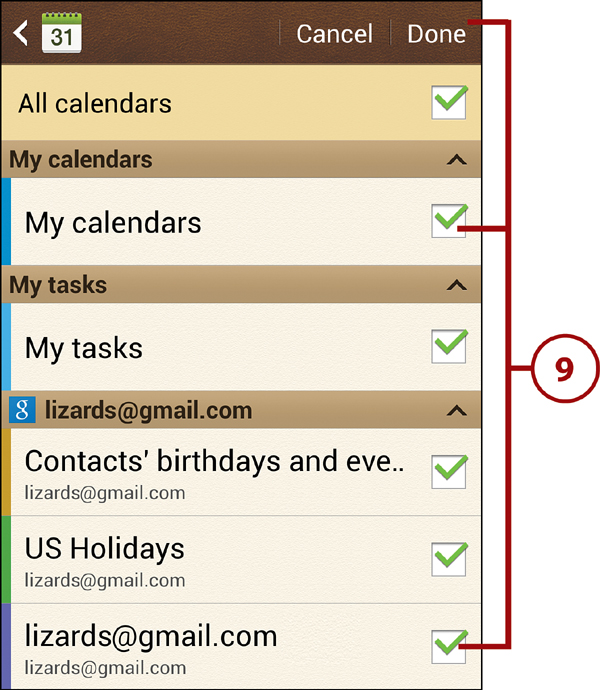
Synchronizing Calendar Data
To quickly perform a manual Calendar sync based on your current account settings, press the Menu key and tap Sync. To learn more about synchronizing data, see Chapter 16.
10. Event Notification settings. These settings determine the manner(s) in which reminders for upcoming events and tasks are presented.
• Tap Set Alerts and Notifications to specify whether a reminder will display as a status bar icon (Status Bar Notification), as a full screen pop-up (Alert), or not at all (Off).
• Tap Select Ringtone to associate a ringtone with reminder alerts. Select Silent if you want to disable this option.
• Enable Vibration if you want Calendar reminders to cause the phone to vibrate. Like other notification settings, you can set Vibrate as the sole notification method or use it in combination with other methods.
• Tap Quick Responses to view, edit, add, or delete brief email responses that you can send in response to event invitations.

